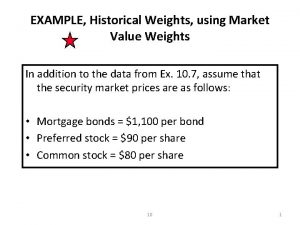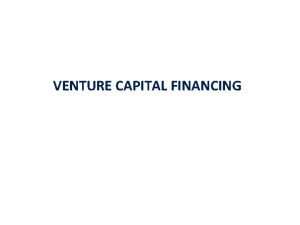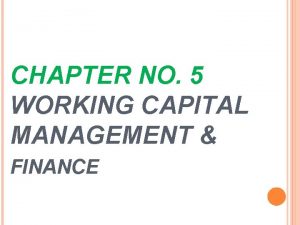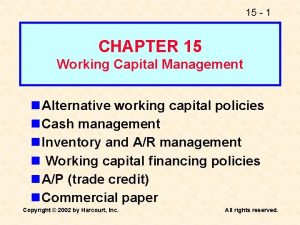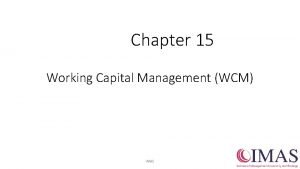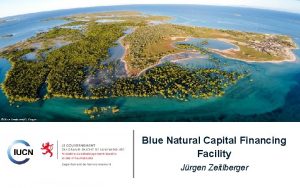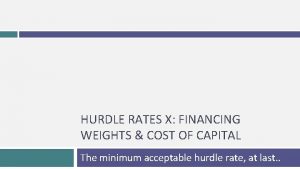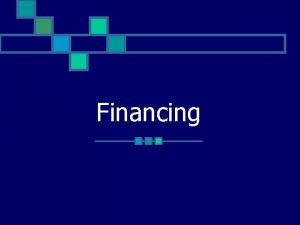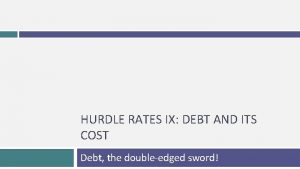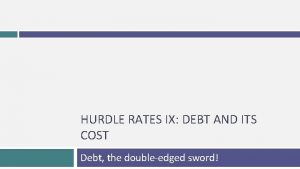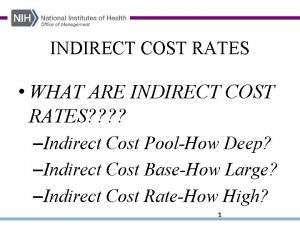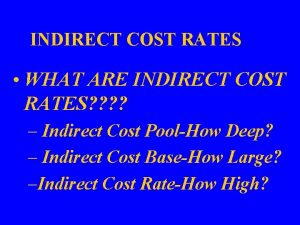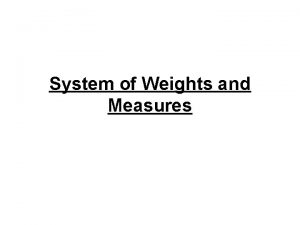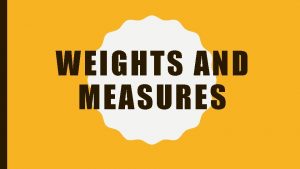HURDLE RATES X FINANCING WEIGHTS COST OF CAPITAL













- Slides: 13

HURDLE RATES X: FINANCING WEIGHTS & COST OF CAPITAL The minimum acceptable hurdle rate, at last. .


Weights for Cost of Capital Calculation The weights used in the cost of capital computation should be market values. There are three specious arguments used against market value Book value is more reliable than market value because it is not as volatile: While it is true that book value does not change as much as market value, this is more a reflection of weakness than strength Using book value rather than market value is a more conservative approach to estimating debt ratios: For most companies, using book values will yield a lower cost of capital than using market value weights. Since accounting returns are computed based upon book value, consistency requires the use of book value in computing cost of capital: While it may seem consistent to use book values for both accounting return and cost of capital calculations, it does not make economic sense. In practical terms, estimating the market value of equity should be easy for a publicly traded firm, but some or all of the debt at most companies is not traded. As a consequence, most practitioners use the book value of debt as a proxy for the market value of debt. 3

Disney: From book value to market value for interest bearing debt… In Disney’s 2013 financial statements, the debt due over time was footnoted. Time due Amount due Weight 0. 5 2 3 4 6 8 9 19 26 28 29 $1, 452 $1, 300 $1, 500 $2, 650 $500 $1, 362 $1, 400 $500 $25 $950 $500 $12, 139 11. 96% 10. 71% 12. 36% 21. 83% 4. 12% 11. 22% 11. 53% 4. 12% 0. 21% 7. 83% 4. 12% Weight *Maturity 0. 06 0. 21 0. 37 0. 87 0. 25 0. 9 1. 04 0. 78 0. 05 2. 19 1. 19 7. 92 Disney’s total debt due, in book value terms, on the balance sheet is $14, 288 million and the total interest expense for the year was $349 million. Using 3. 75% as the pre-tax cost of debt: Estimated MV of Disney Debt = 4

Operating Leases at Disney The “debt value” of operating leases is the present value of the lease payments, at a rate that reflects their risk, usually the pre-tax cost of debt. The pre-tax cost of debt at Disney is 3. 75%. Disney reported $1, 784 million in commitments after year 5. Given that their average commitment over the first 5 years, we assumed 5 years @ $356. 8 million each. 5

6 Application Test: Estimating Market Value Estimate the Market value of equity at your firm and Book Value of equity Market value of debt and book value of debt (If you cannot find the average maturity of your debt, use 3 years): Remember to capitalize the value of operating leases and add them on to both the book value and the market value of debt. Estimate the Weights for equity and debt based upon market value Weights for equity and debt based upon book value 6

Current Cost of Capital: Disney Equity Debt Cost of Equity = Riskfree rate + Beta * Risk Premium = 2. 75% + 1. 0013 (5. 76%) = 8. 52% Market Value of Equity = $121, 878 million Equity/(Debt+Equity ) = 88. 42% After-tax Cost of debt =(Riskfree rate + Default Spread) (1 -t) = (2. 75%+1%) (1 -. 361) = 2. 40% Market Value of Debt = $13, 028+ $2933 = $ 15, 961 million Debt/(Debt +Equity) = 11. 58% Cost of Capital = 8. 52%(. 8842)+ 2. 40%(. 1158) = 7. 81% 121, 878/ (121, 878+15, 961) 7

Divisional Costs of Capital: Disney and Vale Disney Vale 8

Costs of Capital: Tata Motors, Baidu and Bookscape To estimate the costs of capital for Tata Motors in Indian rupees: Cost of capital= 14. 49% (1 -. 2928) + 6. 50% (. 2928) = 12. 15% For Baidu, we follow the same path to estimate a cost of equity in Chinese RMB: Cost of capital = 12. 91% (1 -. 0523) + 3. 45% (. 0523) = 12. 42% For Bookscape, the cost of capital is different depending on whether you look at market or total beta: 9

6 Application Test: Estimating Cost of Capital Using the bottom-up unlevered beta that you computed for your firm, and the values of debt and equity you have estimated for your firm, estimate a bottom-up levered beta and cost of equity for your firm. Based upon the costs of equity and debt that you have estimated, and the weights for each, estimate the cost of capital for your firm. How different would your cost of capital have been, if you used book value weights? 10

Choosing a Hurdle Rate Either the cost of equity or the cost of capital can be used as a hurdle rate, depending upon whether the returns measured are to equity investors or to all claimholders on the firm (capital) If returns are measured to equity investors, the appropriate hurdle rate is the cost of equity. If returns are measured to capital (or the firm), the appropriate hurdle rate is the cost of capital. 11

Back to First Principles 12

Task Estimate a cost of capital for your company (and its businesses) 13 Read Chapter 4
 Target weights vs historical weights
Target weights vs historical weights Multinational capital structure
Multinational capital structure Multinational cost of capital and capital structure
Multinational cost of capital and capital structure Unit ratio
Unit ratio Ratios and proportions guided notes
Ratios and proportions guided notes Ratios rates and unit rates
Ratios rates and unit rates Ratios rates and unit rates
Ratios rates and unit rates Stages of venture capital financing ppt
Stages of venture capital financing ppt Operating cycle method
Operating cycle method Capital financing requirement
Capital financing requirement Working capital financing policy
Working capital financing policy Drags and pulls on liquidity
Drags and pulls on liquidity Blue natural capital financing facility
Blue natural capital financing facility Equitable investment edge
Equitable investment edge
